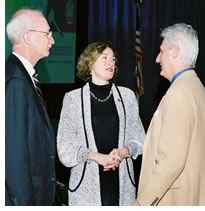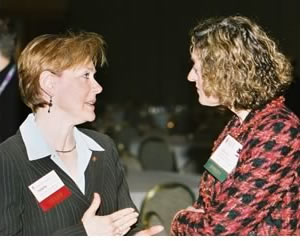

3/2006
Grassroots Town Hall Part 2

 by Chris McEntee
by Chris McEntee
This is the second installment of a two-part recap of AIA EVP/CEO Chris McEntee’s Grassroots Town Hall Forum held February 10 in Washington, D.C. Topics that Chris addresses in this article include diversity, knowledge communities, and public outreach. What follows is a summary of her responses in a live Q&A, edited for publication.
McEntee: The issues focused on in Part 1 in the March 17 AIArchitect were the first raised at the forum. They reflected what might be called the hot-button subjects of practice and, since this was after all an audience of AIA leaders, matters dealing with the organization itself—dues, One AIA, and how to mine the rich but sometimes hidden veins of knowledge here at the national component.
As the participants on both sides of the microphone became comfortable with one another, questions became more subtle and nuanced—diversity, professional inclusiveness, architects and educators—all familiar, all long-standing, all deserving of consideration and fresh insights.
I’ve put the questions that were raised in three buckets: Diversity/Inclusiveness, Knowledge, and Public Advocacy. The first of these—Diversity/Inclusiveness—may seem like something of a catch-all. In a way it is. On the other hand, there is, I think, a common thread—identity: Who are we as an organization and to whom do we relate?
Since the responses I gave at Grassroots were by no means the last or
even the best words on any of the topics, links have been provided to
lead readers to a richer discussion of an issue.
Diversity
“The diversity issue is finally being given some urgency. What
would prevent the AIA from declaring it would fund 50 projects per year
over five years that had enhanced diversity as their goal for $xx and
see how many are successful? I personally feel that anyone running [for
president] should be expected to respond thoughtfully to this [issue],
but it really comes down to the ‘club’—Fellows, CACE,
national staff, et al.”—Anonymous
McEntee: To measure just how much
attention the AIA is in fact giving to initiatives that have greater
diversity as their goal, you have to scan, as this comment suggests,
the entire organization, not just the national component—the
nearly 300 state and local components, the knowledge communities, CACE,
and so forth. We know, for instance, from the 2005 Component Profile
Survey, that 35 components answered “yes” when the question
was asked, “Does your component sponsor events that address issues
of diversity or inclusiveness within the profession?”
But what does that mean? And what were the measurable results? For that matter, what about all those components that answered “no”? And what does that “no” mean? They may be addressing the issue in a constructive way outside of what they would consider sponsored events.
Part of our challenge here at the national component is to have a reliable database of what exactly is going on throughout the organization. (We don’t have it yet, but we will.) We need goals and metrics that will test the impact of these programs. Those that do well will obviously be role models for the rest of us.
Looked at another way, the issue is too important to restrict to 50 or 60 or even a hundred projects. If we’re going to get on top of this issue, diversity has to be evident in the AIA’s culture—how we hire, how we staff, what programs we choose, who we serve, and so forth. At the national level, for example, we have made great strides in recruiting a talented, diverse staff. A snapshot of the men and women who work here would look very different from a picture taken even as recently as a decade ago. More than that, our long-range and strategic plans identify diversity and inclusiveness as values that must inform every single AIA program.
Have the results to date matched our good intentions? I’m afraid not, but we’re working on it and are committed to making a positive, measurable difference.
I believe the real opportunities—and challenges—are to be found among children in grades five and six as well as among the emerging professionals. We know, for example, that today about 50 percent of those being graduated from schools of architecture are women, yet only 12 percent of these join the AIA. I want to know why so that we can work with the schools and other stakeholders to make a difference. One place to look are those schools whose graduates overwhelmingly go into traditional practice, like the University of Maryland, or at the institutions with constant and purposeful connections with firms, like the Boston Architectural Center. What can we learn from them? (Read about the Educators/Practitioners Network.)
 “There
are 160 accredited programs of architecture, and about half of their
graduates have no intention of practicing architecture. NCARB says the
profession is shrinking by one to two percent each year. What incentives
can we offer people to get into and stay in the profession?”—Ted
Landsmark, Assoc. AIA, chair, Diversity Committee, and 2006 Whitney Young
Award recipient
“There
are 160 accredited programs of architecture, and about half of their
graduates have no intention of practicing architecture. NCARB says the
profession is shrinking by one to two percent each year. What incentives
can we offer people to get into and stay in the profession?”—Ted
Landsmark, Assoc. AIA, chair, Diversity Committee, and 2006 Whitney Young
Award recipient
McEntee: In addition to exploring what we know are existing best
practices, in other words those schools whose graduates do go on to practice,
I would want to think carefully about how we—and by “we” I
mean both practice and the academy—regard licensure. If the schools
are not promoting this as a value, that’s a problem that needs
to be addressed. I suppose it really comes down to what honor, respect,
and dignity do we give those who receive their license? Is it a mark
of distinction or simply a painful rite of passage? This is where I would
look when it comes to thinking about incentives. (Learn
more about the American
Institute of Architecture Students and the National
Associates Committee. Associates.)
“How can the AIA welcome government and corporate architects?”—Gretchen
Penney, AIA, president-elect, AIA South Carolina
McEntee: Part of the answer has
to do with attitude. In whatever way architects use their training and
talent to improve our communities—or, to
use the words of the AIA’s old mission statement: “To be
of ever-increasing service to society”—however they make
a contribution, the AIA should embrace them at every level of this organization,
the goal being to build the most respected and influential professional
society. Certainly there should be room in the AIA Honors and Awards
program to celebrate outstanding achievement in the corporate and government
arenas. Another avenue is to pursue research projects that have a direct
benefit to government and corporate architects. (Follow
this link to more about the Corporate Architects Knowledge Community.)
“How do we mitigate the disconnect between architects and educators?”—
A representative from the Educators/Practitioners Network.
McEntee: From the moment I accepted the offer to become executive vice
president/CEO—no,
even before—I gave myself a cram course on AIA history. I know
I’ve got a lot more to learn, but this much is clear: Right from
the first days of its founding back in 1857, education was a top priority.
AIA members played leading roles in establishing this nation’s
first schools of architecture.
You might think this family tree would be a source of unity. Yet, like most families, that very closeness can lead to friction and misunderstanding. Even if friction is inevitable, it’s certainly not desirable. We need one another because we share a common concern or destiny—the future of the profession. Whenever we lose sight of this and get tangled up in questions of turf or respect, we need to remind ourselves it’s not about us; it’s about working together to make sure there is a bright future for an essential profession.
Knowledge Communities
Even if the leadership of the AIA’s Knowledge Communities had not been in the room, the all-embracing topic of knowledge would have surfaced, which, as the following questions make clear, it did.
“The Knowledge Communities have expertise in specialized topics,
but little expertise in knowledge gathering and dissemination. What can
we do?”—James L. Sawyer, AIA, chair, Project Management Knowledge
Community
McEntee: This is a critical issue: Knowledge that isn’t shared
loses its creative and transformative power. So what do we do? The most
obvious first step is to bring together the knowledge communities with
the research and communications professionals on this end. We’ve
got the communications and marketing experts. Let’s use them.
“Often, local knowledge communities are the forum that people
plug into. Are there any plans to unite them with national?”—Peter
Arcone, New York Region
McEntee: Among the other accomplishments of the knowledge communities
is their emergence as a vital point of entry into the AIA. Whatever we
can do to make that portal more accessible is in the best interest of
everyone. Currently, staff is developing a list that identifies existing
local knowledge communities and those state and local components interested
in starting their own. We also have a small pool of money to fund grants
for the national knowledge communities to strengthen outreach efforts
with their local counterparts.
“What can we do to make Grassroots more relevant and useful to
knowledge community leaders? Please rethink either the structure of the
event or whether our presence is even necessary. If we are here, please
figure out a way that we can more constructively engage with components.”—Kerry
Dietz, AIA, Housing Knowledge Community
McEntee: You have to remember that the
inclusion of the knowledge communities in the Grassroots leadership conference
is relatively new. I think maybe just three, maybe four years. So we’re
still learning. Feedback from those we are trying to serve is essential.
This includes, by the way, suggestions from the knowledge community leaders
themselves: What do you believe would make Grassroots more relevant and
useful to you? Give a call, send an e-mail, drop Knowledge
Team Vice President Barb Sido a line. We’re listening.
Public Advocacy
The AIA’s advocacy role and its importance to the members was another subject that prompted comments and questions from Grassroots attendees.
“Do you see any future in client/public education to help architects
be able to negotiate higher fee structures to help the profession financially
gain the status we feel is possible?”—Denise Thompson, Assoc.
AIA, associate director, AIA Pennsylvania
McEntee: Design excellence, as we’ve been told time and again,
is a team effort. The client—who commissions the work—and
the public—the
ultimate client—are pivotal players on the team. Now, if these
team members don’t fully understand or appreciate how much the
architect can do for them, the profession is not going to be appropriately
valued for its services. We know that.
 Bridging the perception gap between what the profession can do and the
client’s awareness of just how to use this great resource is a
story that has to be and is in fact being told by the AIA. A commitment
to telling the story is what drives our national advertising campaign—and
it does make a difference. Data we’ve been gathering confirm what
we’ve been hearing anecdotally: There’s a direct correlation
between an educated client and the profession’s bottom line. Or,
to use the words of a popular advertising campaign: “An educated
consumer is our best customer.” (Read
about the “Shape of
Texas” radio program.)
Bridging the perception gap between what the profession can do and the
client’s awareness of just how to use this great resource is a
story that has to be and is in fact being told by the AIA. A commitment
to telling the story is what drives our national advertising campaign—and
it does make a difference. Data we’ve been gathering confirm what
we’ve been hearing anecdotally: There’s a direct correlation
between an educated client and the profession’s bottom line. Or,
to use the words of a popular advertising campaign: “An educated
consumer is our best customer.” (Read
about the “Shape of
Texas” radio program.)
“Is it possible to extend
AIA member privileges to legislators?”—Jerry
Larson Sr., AIA Jersey Shore
McEntee: That depends on what is meant by “member
privileges.” As
the name outside AIA national headquarters states, this is the American
Institute of Architects. So there is a pretty obvious limit to how far
you can stretch the word “member.”
Having said that, I have become increasingly aware of how creative a number of our components are in providing appropriate points of entry into the organization for non-architects who would like to pursue a mutually beneficial relationship. These components have created a larger, rounder table for architects and interested stakeholders to come together to pursue common interests. It works. All those who sit at that table gain greater visibility as well as credibility in the community, not the least of which is the component itself.
“Should the AIA partner with engineers for
additional representation as a whole?”—Anonymous
McEntee:
This raises the most fundamental question: Who are we? The American Institute
of “Architects” or of “Architecture”?
There’s a long history here, in fact going back to the 1830s, when
architects and civil engineers attempted to found a professional society
that embraced the interests of both groups. That effort ultimately failed,
which is why next year we will be marking the 150th anniversary of an
organization dedicated to serving architects, an effort that did succeed.
However, marriage is not the only way to partner. Architecture is a small profession. The total number of architects serving a population of 350 million or so Americans could be housed in a large football stadium. So the AIA naturally forms alliances with those in the larger design community who share our interests. These alliances constantly shift, because the issues themselves shift. When tomorrow comes, today’s bedfellow may be on the other side of an issue.
Still, we never let differences on specific issues stand in the way of exploring opportunities to speak with one voice. Also, the AIA actively participates in a network of relationships among our professional colleagues. After all, no matter how we exercise our training and experience, the design professions do share a common legacy and mission to provide environments that serve our clients and our communities.
“Could the AIA national
component create a video for high school students on why you should
be an architect?”—Javier
Huerta, AIA
McEntee: Sure it could be done.
Yet, how effective would such a film be? I have a feeling that a young architect of color talking to inner city school students, or a woman sharing her experience as an architect—the challenges, the rewards—or a college student describing life in and outside of the classroom—that these could be life-altering encounters for all concerned.
Videos or brochures can be useful accessories. Yet, based on my own experience, I believe the opportunities to make a real difference in the life of a young man and woman come from personal encounters. Each of us can name an adult who opened our eyes to see the world in a new way, a way that was life-changing. Videos don’t have the same kind of force. Nor do they deliver the reward that comes when something you’ve said or done causes a young person to say “wow” or “thank you.” You can’t buy that kind of love. (Connect to an article about the ACE Mentor Program.)
At the close of the Q&A, John Melcher, AIA, AIA California Council president stood up: “Not a question, but a comment: This dialogue is like a breath of fresh air. Please keep it up.”
Copyright 2006 The American Institute of Architects.
All rights reserved. Home Page ![]()
![]()
Read
Part I of this two-part report on the AIA Grassroots Town Hall Forum. ![]()
![]()